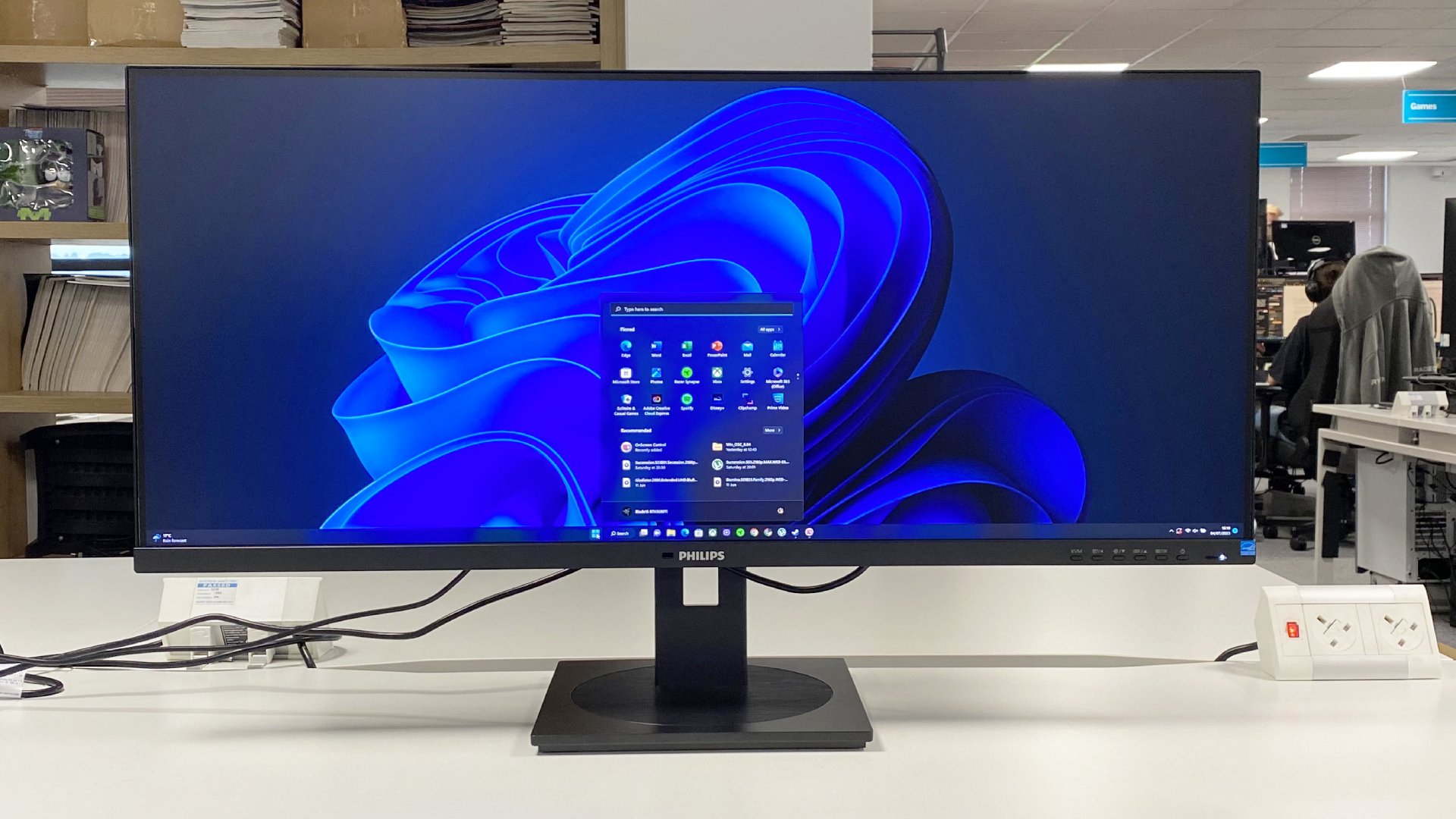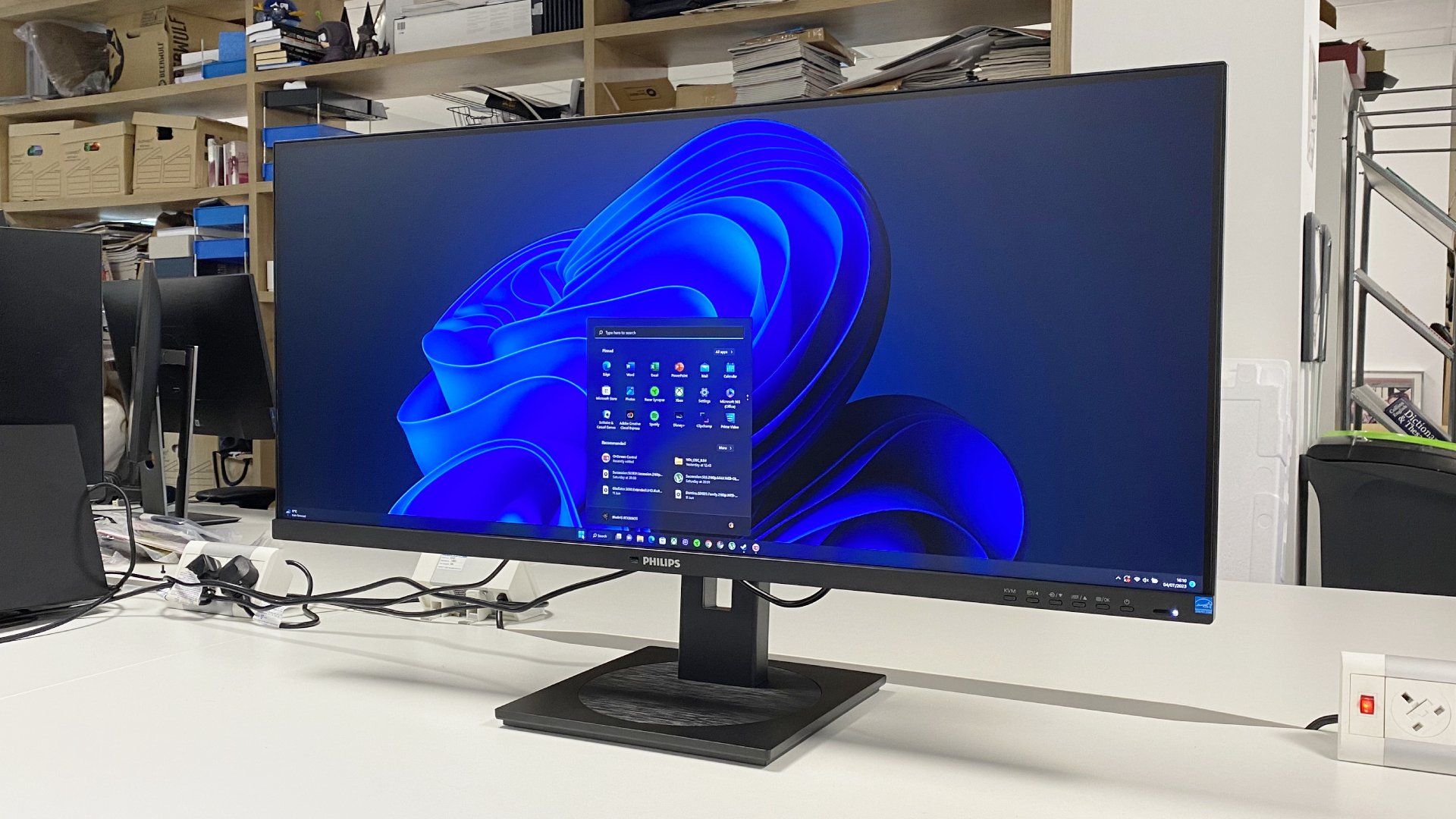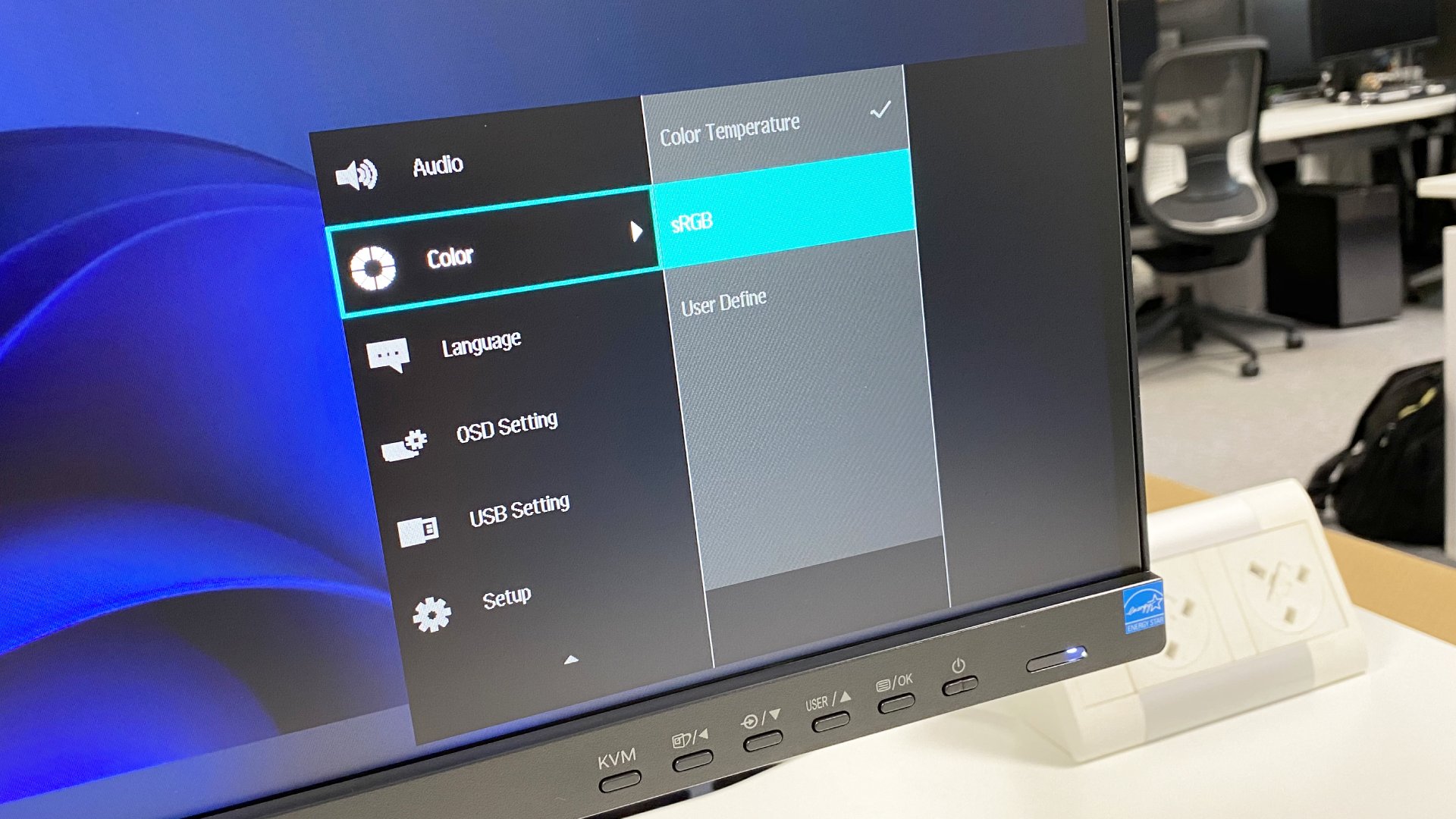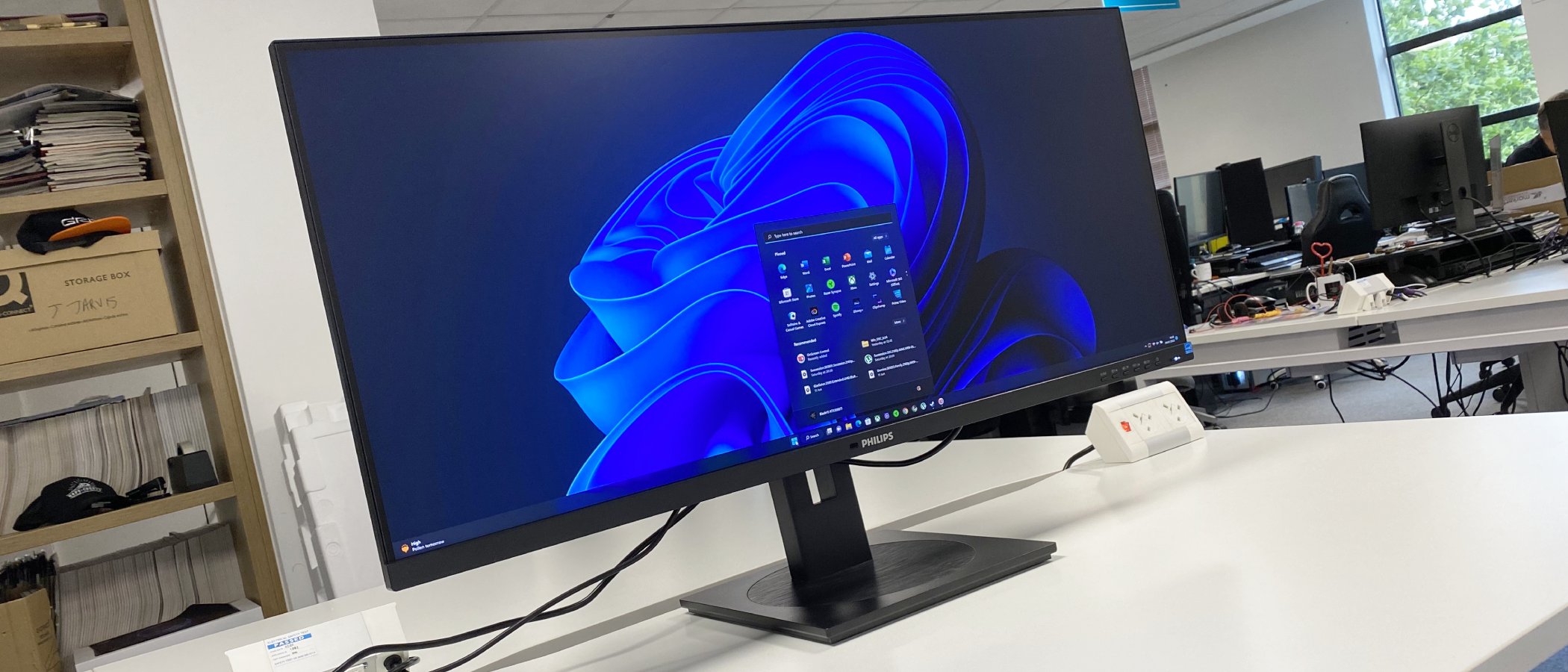TechRadar Verdict
Philips' latest 40-inch widescreen productivity display gives you lots of screen-space for your money and a strong feature set, but the low resolution slightly limits its versatility.
Pros
- +
Lots of monitor for the money
- +
KVM switch
- +
120Hz refresh
Cons
- -
Only 3440 by 1440 resolution
- -
Limited colour space support
- -
Not a true HDR display
Why you can trust TechRadar
With a bigger screen, you can get more done. That's the basic theory behind Philips' latest ultrawide productivity panel, the Philips 40B1U5600. It's a 40-inch beast with a 21:9 aspect ratio.
Aiming to be one of the best business monitors with a large panel and plenty of screen real estate, it adds a range of features that help you get work done. For starters, there's a KVM switch allowing you to share this monitor across two computers. Then there's USB-C connectivity with power delivery, so you can drive the display, charge your laptop and connect peripherals, all with a single cable.
For image quality, the good news is that you get an IPS panel that supports HDR and runs at 120Hz. That relatively high refresh is normally the preserve of gaming monitors. But it has a benefit for general computing in terms of day-to-day smoothness and responsiveness.
Similar thinking applies to HDR support. It's not directly relevant for most mainstream workflows, but it's nice to have. If all that sounds impressive, there is a catch. The Philips 40B1U5600 only offers a native resolution of 3440 by 1440. That's pretty low for such a large display.
Likewise, the HDR support is fairly limited and the USB-C charging power tops out at just 15W. That latter figure is arguably the most problematic of all, as it's not enough to stop even the best business laptops from discharging when under moderate to heavy load.
Philips 40B1U5600: Design & features

- Strong feature set
- KVM switch
- Mostly good connectivity
- USB-C limited to 15W power delivery
Panel size: 40-inch
Panel type: IPS
Resolution: 3440 x 1440
Brightness: 500 cd/m2
Contrast: 1,200:1
Pixel response: 4ms
Colour coverage: 121% sRGB
HDR: DisplayHDR 400
Refresh rate: 120Hz
Vesa: 100mm x 100mm
Inputs: DisplayPort 1.4 x1, HDMI 2.0 x1, USB-C with 100W power delivery x1
As a productivity-oriented monitor, it's no surprise to find the Philips 40B1U5600 is pretty sober suited. The all-black plastics and unadorned, straight-edged design is fairly anonymous. That said, the large 40-inch panel size and ultrawide 21:9 aspect ratio do make for plenty of desktop appeal. This isn't your average office monitor.
It's also pretty ergonomic for such a large display, thanks to a stand that adjusts for height, tilt and swivel and a plug-out arm for hanging headphones. Speaking of ergonomics, most ultrawide displays of this large scale feature a curved rather than flat screen.
Sign up to the TechRadar Pro newsletter to get all the top news, opinion, features and guidance your business needs to succeed!
Consequently, it's notable that the edges of the display do feel like they're at quite an oblique angle when viewing the monitor from a normal working distance. In the end curved versus flat is a personal preference. But if curved makes sense at all, it makes sense on this size and format of display and a gentle curve would probably be preferable here.
Whatever, you also get a KVM switch allowing this monitor to share a single keyboard and mouse across two computers. Even better, there's USB-C connectivity with power delivery. That means you can drive the display, charge your laptop and connect peripherals, all with a single cable.
Philips has specified the power delivery at 100W, which should be enough to keep even pretty high performance desktop replacement laptops fully charged under fairly heavy load. All of which means this monitor is very well specified in terms of connectivity and ergonomics.
Philips 40B1U5600: Performance

- Nice IPS panel
- Low pixel density
- Limited colour space and HDR support
The Philips 40B1U5600's IPS panel is a decent performer. It's rated at up to 500 nits, which is plenty of punch for all by the brightest indoor ambient light conditions.
There is HDR support, but it's the entry-level HDR400 variety, which means no local dimming and limited dynamic range. This isn't a true HDR monitor, but it does support an HDR signal and will show the colours correctly.
It's just a pity that the colour balance of SDR content in HDR mode is a little off. In practice, that means you'll have to toggle between HDR and SDR modes depending on content type to ensure the best image quality results. That's a bit of a pain, but probably only a problem if you need to view HDR content regularly.
Similarly, the OSD menu offers a pretty limited range of colour spaces, with just sRGB beyond the default user mode. So, don’t go in expecting one of the best monitors for photo editing or the best video editing monitor. It’s not aimed at those users, and as such, it's not the end of the world that there's no Adobe RGB or DCI-P3 mode. And the IPS panel is pretty well calibrated and offers pleasing, well saturated colours and decent contrast for this panel type.
The 120Hz refresh support is also a nice extra. It's not strictly necessary for most workflows. But it makes for an added sense of smoothness and responsiveness for day-to-day computing. Put simply, once you've tried 120Hz or higher, you won't want to go back to the old school 60Hz experience. 120Hz is just better.
What's more, you get user-configurable overdrive, so you can tweak the response to your preference. This is a fairly quick display and even if it's not actually designed for gaming it isn't actually half bad as a gaming panel.
Where it isn't so good is pixel density. The 3440 by 1440 pixel native resolution is pretty low for a 40-inch ultrawide panel and makes for low pixel density. As a result, images aren't as sharp as higher resolution monitors and font rendering isn't as sharp.
In Windows, font rendering is tolerable on this display and as an overall productivity device, the Philips 40B1U5600 is pretty appealing. However, in MacOS using, say, an Apple MacBook, text is very soft due to the low pixel density.
Philips 40B1U5600: Final verdict

As a big screen for getting stuff done, the Philips 40B1U5600 has lots to recommend it. The connectivity, including a KVM switch and USB-C with 100W of power delivery is great. The core image quality of the 40-inch ultrawide IPS panel is pretty nice, too.
The basic HDR support plus 120Hz refresh are likewise welcome extras and ensure this monitor is pretty versatile and very pleasant to use day-to-day. It'll even make a decent fist of playing games.
Despite all that, there is one pretty obvious limitation and it's pixel density. 3440 by 1440 is quite a low resolution for this large a monitor and both overall sharpness and font rendering do suffer. For Windows users, this remains a pretty usable monitor. But this is in no way one of the best monitors for MacBook Pro laptops and Macs, and we'd advise Apple users to steer clear since macOS isn't terribly well-optimised in terms of font rendering for pixel density this low.
Pair the Philips 40B1U5600 monitor with the best business computers - tested, reviewed, and rated by us
- Get the best deal on your next Philips purchase with our Philips promo codes.
Technology and cars. Increasingly the twain shall meet. Which is handy, because Jeremy (Twitter) is addicted to both. Long-time tech journalist, former editor of iCar magazine and incumbent car guru for T3 magazine, Jeremy reckons in-car technology is about to go thermonuclear. No, not exploding cars. That would be silly. And dangerous. But rather an explosive period of unprecedented innovation. Enjoy the ride.
